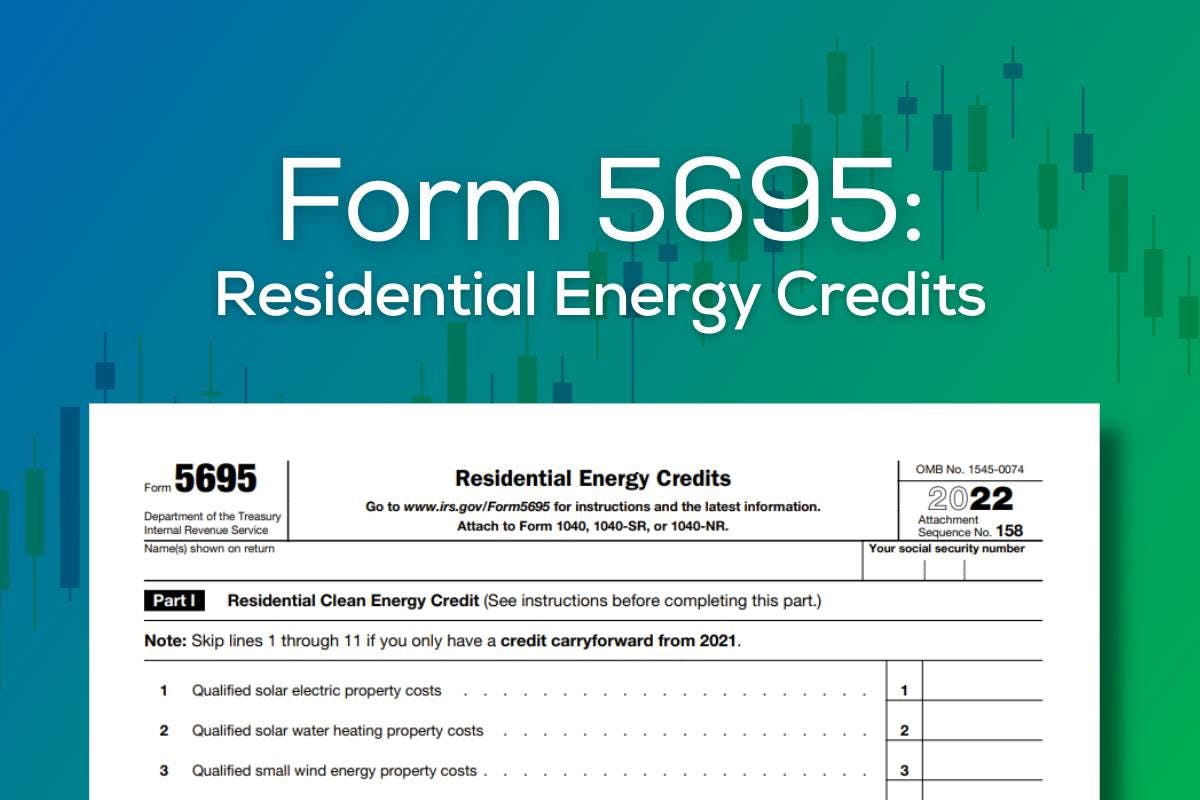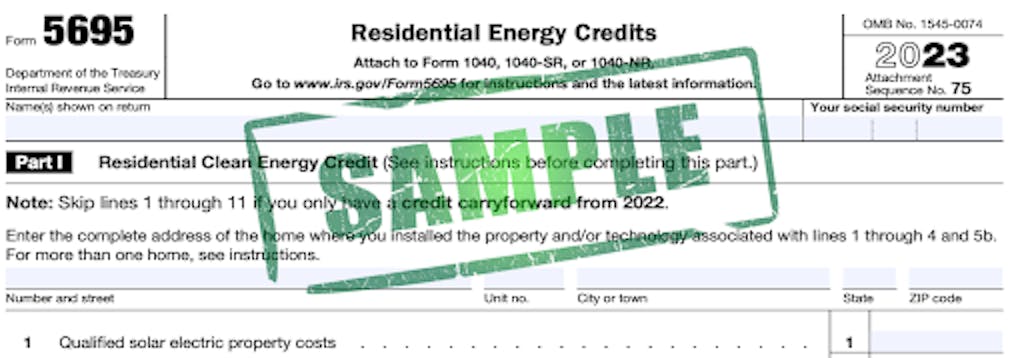

Author  Cory O'Brien Senior Director - Growth Marketing Editor
Cory O'Brien Senior Director - Growth Marketing Editor  Ryan Barnett SVP, Policy & New Market Development
Ryan Barnett SVP, Policy & New Market Development
In this article
The Residential Clean Energy Credit, commonly known as the Solar Tax Credit, is one of the biggest draws for homeowners turning to solar energy. This residential energy credit can save you a lot of money in taxes, but you must make a proper claim using Form 5695 to receive that money.
Plus, in 2024, Form 5695 isn’t just for solar panels and can be used to finance both a number of qualified energy efficiency improvements and residential energy property expenditures.
If you’re wondering how to fill out form 5695 and claim the solar tax credit, then this article is for you. With these step-by-step Form 5695 instructions, you can better understand the process for receiving the credit you deserve.
Form 5695 is the document you submit to get a credit on your tax return for installing solar panels on your home. We commonly think of Tax Form 5695 as the Residential Clean Energy Credit Form.
You can request a copy of Form 5695 from the Internal Revenue Service (IRS) Website, and also review their Form 5695 instructions.
The document itself discusses a concept called “Residential Energy Credits” which is the specific term used by the IRS to calculate non-refundable credit for a residential energy-efficient property. However, only qualified residential energy-efficient improvements in the United States are eligible for the credits. This includes renovations such as residential solar panel systems, solar energy storage, fuel cells, geothermal heat pumps, and small wind turbines.
In 2024, there is now a second section on Form 5695 for homeowners to earn an additional $1,200 in tax credits for home energy audits and other qualified energy-efficiency updates such as new windows, doors, insulation, roofing, and more.
The Solar Tax Credit is a federal tax credit for solar systems you can claim on your income taxes, and reduces your federal tax liability. The tax credit is calculated based on a percentage (30% in the year 2024) of the total cost of your solar energy system.
This federal residential solar energy credit makes solar energy more affordable by giving a dollar-for-dollar tax reduction. Your solar energy system must have started service during the current tax year to qualify for the credit and need IRS Form 5695.
Since these tax credits are not deductions, they generally reduce the amount of tax the claimant owes, which can create a tax refund. The tax credit is also not a “discount” as taxpayers still have to bear the cost of the improvements, and then claim the credit from the IRS when filing their tax returns. Taxpayers can claim these credits on IRS Form 5695 regardless of whether or not they itemize deductions on Schedule A.
For solar projects on new and existing homes in the U.S., the Residential Clean Energy Credit can be claimed today if the following requirements are met.
Beyond using Form 5695 for the solar tax credit, there may be some additional state income tax credits available for homeowners in the United States. In 2024, there are only a handful of states that offer income tax credits for solar energy systems, including:
Note: State solar incentive programs are constantly evolving and may become available or unavailable anywhere, at any time. While you will not use Form 5695 for state-level clean energy incentives, a Palmetto expert can help you identify and claim all of the credits and rebates for which you may be eligible.

The Residential Clean Energy Credit is a big incentive for people to adopt any number of energy-efficient systems on their property. Claiming the solar energy tax credit can offset some of the expenses of making energy-efficient improvements to your home.
However, not all taxpayers and improvements qualify for the credits. Your improvements must meet specific energy efficiency requirements, and first-time homebuyers must adhere to particular rules to qualify.
Review the IRS Form 5695 Instructions to confirm your eligibility. You can then complete the form and include it on Form 1040.
The total system costs of the solar power system for your home is the gross (total) amount you spent on it from your solar company, minus any other cash rebates you received, including state tax credit, incentives, and rebates. Add this number to line 1.
When talking to potential solar installers, it is important to verify the exact details of your quote and discover your total buying costs with and without the solar credit. Total system price includes every necessary project line item, including equipment, labor, wiring, permitting, inverter, and other associated costs.
Fill in the total cost of any other qualifying energy upgrades you might have made on lines 2 through 5. These additional home improvements include home solar water heating, small wind energy generators, geothermal heat pump property costs, and battery storage with a capacity of “at least 3 kilowatt-hours.” Add these up for line 6a.
Note: Other Energy Efficiency upgrades (such as insulation, skylights, and other home improvements) may be added to Form 5895 Part II.

Calculate the federal solar tax credit you qualify for by multiplying the number from line 6a by 30%. Place the answer on line 6b. If you are not receiving a tax credit for fuel cells, you can skip lines 7 through 11.
If this is your first time filing Form 5695 for the solar tax credit, then you can enter the value from line 6b into line 13 – that is, unless you also purchased fuel cells or have any tax credits to carry forward from the previous year. In these cases, line 13 will be the total of line 6b and 11 or 12, depending.
Calculate if you have sufficient tax liability from your taxable income to get the full 30% tax credit available in one year. For the best results, income tax liability calculation should be done with the help of a trained professional.
Calculate the maximum tax credit you can claim by turning to page 4 and completing the instructions for that worksheet. You will need to include any information about any other tax credits for which you qualify, including buying an electric vehicle, being a first-time homeowner, or interest on your mortgage.
Enter the result of the Residential Clean Energy Credit worksheet (the limit of the tax credits you can claim) to line 14. Compare the values of lines 13 and 14 and put the smaller of the two on line 15 of the form.

Compare your tax liability from step 5 with your tax credits. If your tax liability is smaller, calculate the amount you can claim on next year's taxes by subtracting the value on line 15 from line 13. Enter the result on line 16.
The value you filled on line 15 is the amount the IRS will credit on your taxes this year. Enter this number on line 5 of Schedule 3 on Form 1040.If you make additional energy-efficient home improvements in the fiscal year, you may qualify for other tax credits. If so, you will need to complete the second page of Form 5695.
Form 5695 must be completed for the tax year in which your solar panel system was installed.
For example, let's say that you purchase solar panels in February 2024, and they are installed during the first week of May. In this scenario, you should fill out the form whenever you are filing your 2024 taxes, which – for most people – falls in the late winter or early spring of 2025.
When claiming the federal 30% credit for a solar electric system, there is no financial limit on the potential value of your tax credit. With that said, there are many limitations that will cap the total price of your solar energy system, including capacity limits, property challenges, and budget constraints.
If your federal income liability is smaller than your solar tax credit, fear not, as the solar tax credit can “roll over” year after year until it is paid off. For example, let’s say you have a $4,000 tax liability and a $6,000 tax credit. In this instance, you could put the excess $2,000 credit towards your federal income liability the following calendar year.
If you are a homeowner with solar panels, the depreciation of your system should garner no tax implications. Instead, solar panel depreciation deductions are generally only available for business owners or clean energy systems on commercial properties.
Yes, Form 5695 for the Solar Tax Credit can usually be claimed online, alongside the rest of your tax filing. Whether you utilize consumer software, file independently, or work with a tax professional, Form 5695 can be found online, filled out, and attached to your records using a number of resources from the IRS and private businesses.
The solar tax credit makes investing in solar panels a wise financial investment for your home. Earning the Residential Clean Energy Credit includes the following steps:
Palmetto is a clean energy company that believes solar power can change our world for the better, but we are not tax preparation experts. We recommend that you seek out the advice of a licensed accountant or tax professional if you have any specific questions about filling out Form 5695 to claim the Residential Clean Energy Credit.
Palmetto is committed to providing green solutions for a clean and renewable energy future, including solar power systems, battery storage, and our Palmetto Protect monitoring service. Contact us to learn more about how we can help you maximize your solar experience.
Disclaimer: Disclaimer: This content is for educational purposes only. Palmetto does not provide tax, legal, or accounting advice. Please consult your own tax, legal, and accounting advisors.

About the Author Cory O'Brien Senior Director - Growth Marketing
Cory brings over 8 years of solar expertise to Palmetto, and enjoys sharing that knowledge with others looking to improve their carbon footprint. A dog lover residing in Asheville, NC with his wife, Cory graduated from UCSB. If you run into him, ask him about the company he founded to rate and review beer!
Rooftop solar systems work well with smart home technology appliances, electronics, and EV chargers. Learn the how you can benefit in our guide.
Until the grid runs on 100% renewable energy, residential solar will be key to cleaning up energy at home.